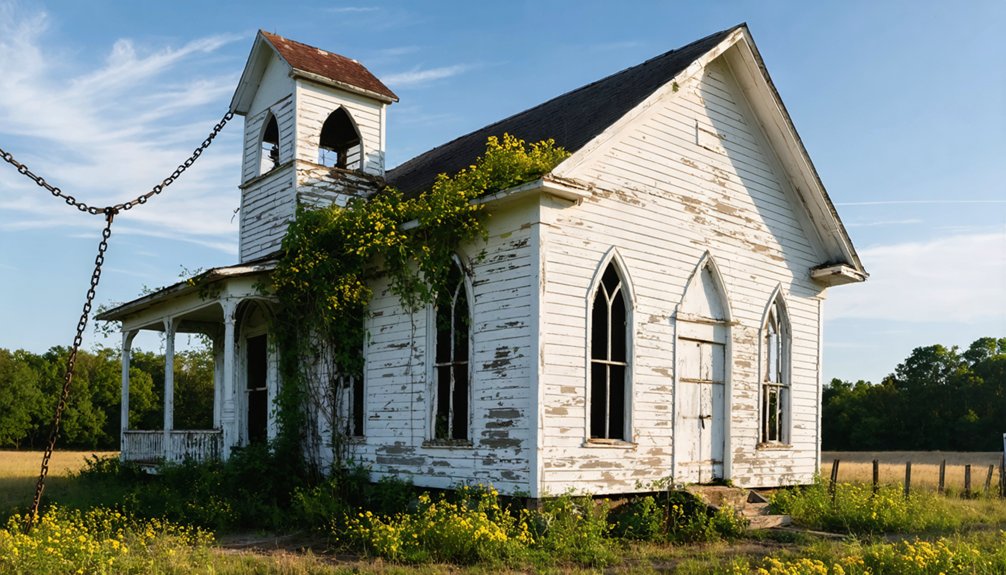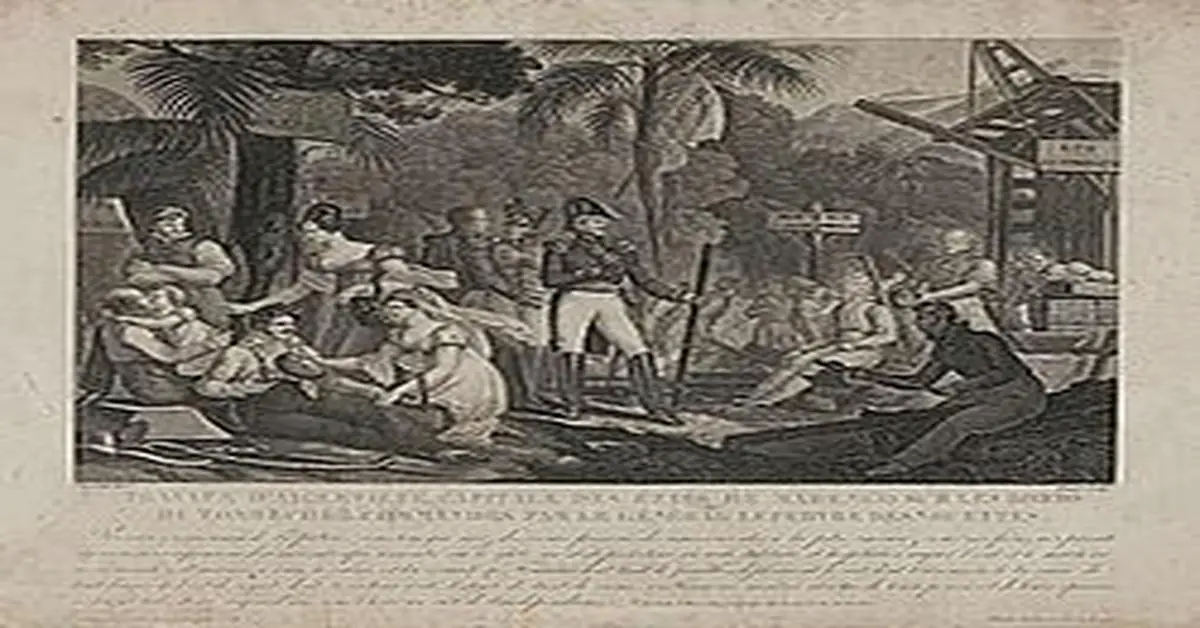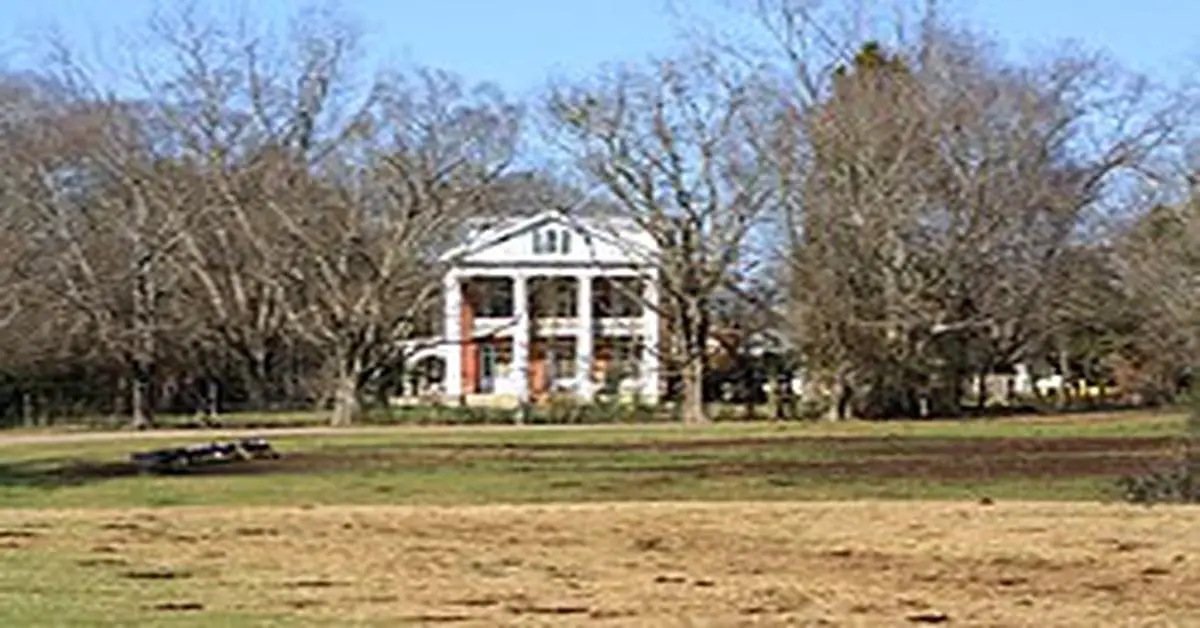You’ll find Stanton’s crumbling remnants along Alabama’s riverbanks, where this former gold mining boomtown flourished in the 1840s. The town transformed from a small settlement into a bustling community with general stores, mining equipment shops, and hotels after gold’s discovery. Miners earned up to $1.75 per day until the late 19th century when gold deposits were exhausted. Today, three historic houses and mill ruins reveal Stanton’s golden legacy.
Key Takeaways
- Stanton transformed from a small settlement into a thriving mining town during the 1840s gold rush in Alabama.
- The town featured essential services including general stores, mining equipment shops, hotels, and civic institutions during its peak.
- Mining operations evolved from placer mining to underground methods, using equipment like stamp mills and mercury amalgamation techniques.
- Economic decline began after gold deposits were exhausted in the late 19th century, causing residents to flee.
- Today, Stanton exists as a ghost town with three surviving houses, requiring property owner permission for access.
The Birth of a Mining Boomtown
While Alabama’s agricultural roots ran deep, the discovery of rich mineral deposits in the 1840s transformed the state’s economic landscape and gave birth to numerous mining communities.
You’ll find that systematic mining operations began around 1856 in the Cahaba Coal Field near Montevallo, marking a pivotal shift in the region’s mining heritage.
During the Civil War, Alabama proudly served as the primary coal supplier to Confederate forces.
The economic transformation accelerated when visionaries like Frank Gilmer and John T. Milner established Red Mountain’s first working ore mine in 1863.
The pioneering efforts of Gilmer and Milner at Red Mountain marked a turning point in Alabama’s evolution from agriculture to industry.
This rapid industrialization sparked the creation of company towns, complete with housing, schools, and essential infrastructure. Baylis Earle Grace had already pioneered early hematite extraction for local blacksmiths in the area.
The arrival of critical rail lines, including the Birmingham & Pratt Mines Railroad in 1878, connected these bustling communities to urban markets, cementing their role in Alabama’s industrial revolution.
Gold Rush Days and Peak Years
During Alabama’s 1840s gold rush, you’ll find Stanton rapidly transformed from a small settlement into a bustling mining town with hundreds of employed miners and essential equipment like sluice boxes and open pit operations.
You can trace the town’s dramatic growth through its expanding infrastructure, which included multiple general stores, mining equipment shops, hotels, and civic institutions like churches and a school.
At its peak, you’d have witnessed a population surge that mirrored other Alabama gold towns like Arbacoochee, which reached 5,000 residents before the California Gold Rush drew miners westward in 1849. When the 1849 exodus began, Stanton, like many Alabama mining towns, saw its population dramatically decline.
Miners in Stanton earned between $0.75 and $1.75 per day working the gold fields, which helped sustain the local economy.
Gold Discovery and Settlement
After gold was discovered in Alabama’s early 1830s, Stanton and its surrounding regions quickly emerged as significant mining areas.
Geographical surveys identified the gold-rich areas within a crystalline belt region that extended through parts of Georgia and the Carolinas. Prospectors like Mr. Johnson in 1839 sparked a rush that transformed the quiet countryside into bustling gold mining communities. One such location was Hatchet Creek, where rich gold gravels supported around fifty workers in 1840. The discovery led to rapid settlement growth, with towns expanding to accommodate thousands of fortune seekers by the mid-1840s.
- Primitive washing methods revealed placer deposits in local creek beds
- Miners used sluice troughs and rocker boxes for efficient gold recovery
- Community dynamics evolved as merchants and services followed the miners
- Population swelled to 5,000 in some boom towns by 1845
- Various groups, including skilled Cornish miners, contributed to the area’s development
Mining Operations and Equipment
The mining operations in Stanton evolved rapidly from simple placer mining to more sophisticated underground methods as prospectors sought deeper gold deposits.
You’d have seen miners using sluice boxes along creeks during early placer mining, where they’d separate gold from sediment using water flow. As operations expanded, stamp mills became the cornerstone of mining equipment, with powerful waterwheels driving these ore-crushing machines.
The extraction techniques grew more complex over time. You’d find miners using mercury amalgamation to capture fine gold particles, though the process was often hampered by graphite in the ore. The six-stamp mill operation at Silver Hill Mine demonstrated the scale of industrial mining in the region.
Horse carts transported hand-dug ore from mines, utilizing unloading ramps to deposit material into the mills.
Later, they’d implement cyanide processing to improve gold recovery rates. The mines featured an array of equipment including water-powered machinery, underground tunnel supports, and processing facilities designed to handle the area’s challenging low-grade ore.
Population Peak and Prosperity
Unlike many Alabama settlements that experienced dramatic gold rush booms, Stanton’s population growth followed a more modest trajectory tied to agricultural development.
You won’t find records of massive migrations or sudden prosperity that characterized mining towns of the era. Instead, the community’s population trends reflect a steady rural presence anchored by churches and agricultural activities.
The town’s slow decline mirrors a common pattern seen in neglected ghost towns across America, where visible remnants of buildings and roads still stand as testament to its past. Similar to how Fort Stanton in New Mexico evolved, the Alabama town’s transformation from settlement to abandonment followed a gradual path.
- The establishment of Ebenezer Baptist Church in 1819 marked the beginning of organized community life.
- Post office operations from 1883 to 2006 indicate sustained but modest population levels.
- Community dynamics centered around two churches and scattered farming households.
- The 1932 tornado dealt a significant blow to population growth, claiming seven lives.
- Unlike boom-and-bust mining towns, Stanton’s decline was gradual and linked to broader rural depopulation.
Daily Life in Historic Stanton
Life in historic Stanton revolved around a vibrant main street where residents could access essential services and social venues.
You’d find multiple drugstores that served as social hubs while providing medical supplies, and several doctors maintained practices to care for the townspeople’s health needs. Community connectivity flourished through the post office, which remained active until the mid-1990s.
Your daily routines might’ve included visits to the feed store for agricultural supplies, stops at the blacksmith for repairs, or evening gatherings at local saloons.
Gas-lit street lamps illuminated your path as you moved between businesses. The military outpost‘s presence guaranteed safety, while social interactions happened naturally at gathering spots like the general store, where you’d catch up on local news and stock up on household essentials.
Mining Operations and Economic Impact
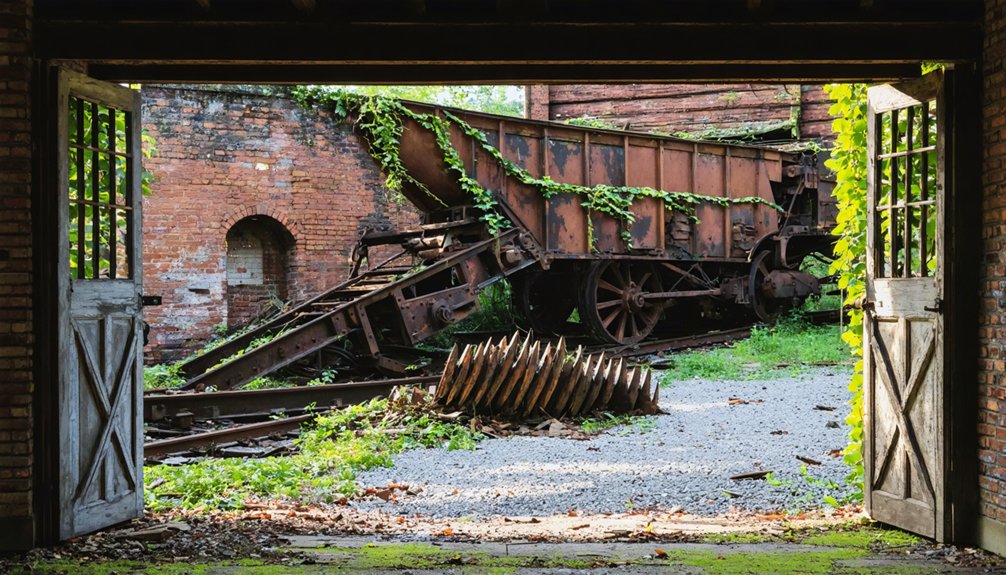
Mining operations transformed Stanton’s economic landscape after coal deposits were discovered in the region during the mid-19th century.
Early mining techniques were basic, but you’ll find they evolved rapidly as railroad connections opened new markets. The area’s labor dynamics shifted dramatically with the influx of workers from diverse backgrounds, including former slaves and immigrants seeking opportunity.
- Underground mining operations created numerous jobs, turning Stanton into a bustling economic hub.
- The railroad’s arrival amplified mining productivity and connected Stanton to broader markets.
- Mining companies established operations that drew workers from across the region.
- Local infrastructure expanded to support the growing mining operations.
- Convict labor played a controversial role in the area’s mining activities, reflecting broader social issues of the era.
The Decline and Abandonment
After a significant gold strike on Rich Hill in 1863 yielded $100,000 within six months, Stanton experienced a dramatic boom-and-bust cycle that would ultimately lead to its downfall.
The 1863 Rich Hill gold discovery sparked Stanton’s meteoric rise and devastating fall, as $100,000 in precious metal beckoned fortune seekers.
When gold deposits were exhausted by the late 19th century, you’d have witnessed a rapid community collapse as miners and their families fled in search of new opportunities.
The town’s economic vulnerability became evident as it had failed to diversify beyond gold mining. Without alternative industries in agriculture, manufacturing, or trade, Stanton couldn’t sustain its population or businesses.
Schools, churches, and social institutions shuttered their doors as residents departed. Buildings fell into disrepair, and nature began reclaiming the land.
Today, you’ll find Stanton serving as a recreational prospecting camp, owned by the Lost Dutchman’s Mining Association.
Surviving Structures and Remnants

Today, you’ll find just three houses standing along a solitary street in Stanton, marking the last vestiges of what was once a bustling mining community.
These early 20th-century structures, weathered by time, reveal architectural features typical of the mining boom era. While the town’s civic buildings have vanished completely, the riverbank holds valuable clues to Stanton’s past through artifact recovery efforts.
- Original tongue-and-groove lumber discovered near the riverbank confirms period construction methods
- Remnants of a sawmill and grist mill operation dot the riverbed
- Archaeological finds include antique bottles and pyrite rocks from the industrial period
- The three surviving homes show signs of abandonment but attract occasional campers
- The river preserves significant sedimentary evidence of human activity and industrial operations
Modern-Day Ownership and Access
If you’re planning to explore Stanton today, you’ll need to be aware that the ghost town’s land parcels are likely privately owned, requiring permission before visiting.
The absence of public facilities, maintained roads, or official heritage site status means there’s no guaranteed right of access for visitors.
You’ll want to research current property ownership and obtain necessary permissions to avoid trespassing violations, as Alabama state laws protect private property rights even in abandoned locations.
Property Rights Today
While the buildings of Stanton stand abandoned, the ghost town’s properties remain under clear legal ownership, primarily held by private individuals and companies.
Property ownership comes with specific rights and responsibilities, even for these historic parcels. You’ll find that legal complexities often arise from inheritance, fragmented titles, and potential liens on the properties.
- You must obtain permission from property owners to legally access or explore any part of Stanton
- Current owners retain full rights to develop or sell their parcels, subject to local zoning laws
- Property taxes must be paid regardless of the land’s abandoned status
- Environmental and historical preservation regulations may restrict development options
- Title searches through county records can verify current ownership and any existing claims
Visiting Rules and Permissions
The clear ownership status of Stanton’s properties directly shapes modern visiting rules and access permissions.
When you’re planning to explore this ghost town, you’ll need to follow specific access guidelines that protect both historical structures and private property rights. Basic visiting etiquette requires that you respect any posted signs, stay within designated public areas, and avoid trespassing on private land.
You’re generally free to take personal photographs, but commercial photography requires special permission. If you’re interested in guided tours, they may be available through local historical societies.
Remember to exercise caution around abandoned structures and don’t remove any artifacts or materials from the site. It’s essential that you check current access conditions before visiting, as hours and permissions can change based on preservation efforts or private owner preferences.
Historical Significance in Alabama
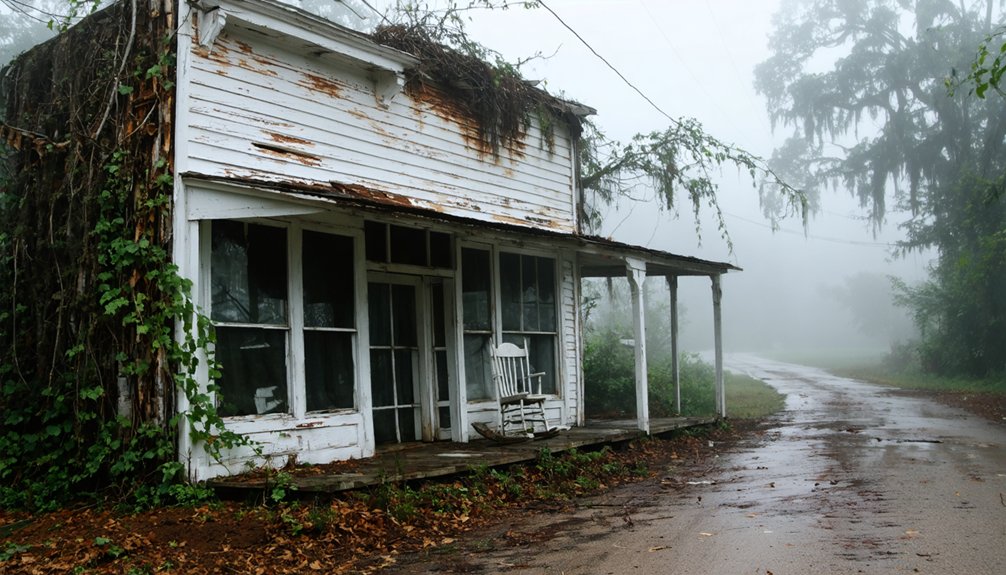
Located approximately 20 miles north of Selma in Chilton County, Stanton stands as a symbol of Alabama’s small-town heritage and agricultural roots.
This once-thriving community reflects the state’s broader cultural heritage through its preserved churches and historic structures. You’ll find evidence of its rich community life in landmarks like the Ebenezer Baptist Church, which remains a functioning state historic site.
- Early settlers were drawn to the area’s fertile soil and abundant timber resources.
- Two functioning churches serve as representations of the town’s religious foundations.
- Local economic activities centered around agriculture and forestry.
- The town’s development paralleled the growth of other rural Alabama communities.
- Historical wooden buildings and storefronts remain as silent witnesses to Stanton’s past.
Exploration and Recreation Today
Modern visitors exploring Stanton today will find a quiet, rural landscape that bears little resemblance to its former bustling community life.
Time has transformed Stanton from a lively community into a serene countryside, where silence now speaks of its past.
You’ll discover limited structural remains, but the area offers opportunities for historical exploration and outdoor recreation.
For exploration tips, remember to prepare for rural terrain and obtain necessary permissions, as much of the surrounding land is privately owned.
You can combine your visit with trips to nearby historical sites, including Ebenezer Baptist Church and Civil War battle locations.
Recreational activities in the area include hiking, bird watching, and rural photography.
While there aren’t marked trails or visitor facilities specifically in Stanton, you’ll find the surrounding Chilton County landscape ideal for outdoor adventures.
Consider timing your visit during local heritage celebrations to enhance your ghost town exploration experience.
Frequently Asked Questions
Were Any Famous Outlaws or Notable Historical Figures Associated With Stanton?
You won’t find any confirmed outlaw legends or notable historical figures associated with this location, though Creek Indians from the Tooktocaugee village once called the area their home.
What Native American Tribes Originally Inhabited the Stanton Area?
While no tribe had permanent settlements directly in Stanton, you’ll find both Creek and Cherokee heritage shaped the region. The Creek (Muscogee) Confederacy dominated central Alabama first, followed by Cherokee influence.
Did Stanton Have Its Own School System During Its Peak Years?
You won’t find evidence of a dedicated school system in Stanton during its peak years. Historical records and demographic data don’t show any established educational facilities in this small Alabama settlement.
Were There Any Major Natural Disasters That Affected Stanton’s Development?
While you might expect dramatic natural calamities, there’s no documented evidence of major disasters directly impacting Stanton’s development, though typical Alabama environmental impacts like droughts and tornadoes likely occurred.
What Other Minerals Besides Gold Were Mined in the Stanton Area?
You’ll find iron mining was significant, with mineral deposits including copper, clay, graphite, and mica. The area also yielded sand, gravel, and various industrial minerals like limestone.
References
- https://ohtheplacestheygo.wordpress.com/2013/02/15/a-ghost-town-and-downtown-wickenburg/
- https://digitalalabama.com/article/alabama-ghost-towns
- https://freepages.history.rootsweb.com/~gtusa/usa/al.htm
- https://digitalalabama.com/topic/chilton-county-alabama-ghost-towns
- https://wherestreve.com/tag/ghost-town/
- https://en.wikipedia.org/wiki/List_of_ghost_towns_in_Alabama
- https://www.youtube.com/watch?v=ODsb1kI_KN0
- https://soul-grown.com/how-a-historic-mining-town-became-one-of-alabamas-favorite-parks/
- https://www.alabamalegacy.org/coal-mining/
- https://blogs.loc.gov/maps/2024/03/tracing-the-alabama-coal-fields/
